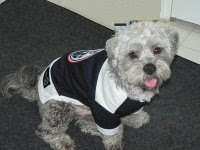Linda Hutcheon notes in her text A Theory of Adaptation that everyone has a theory on adaptation. My theory changes with almost every adaptation, for I'm exposed to some sort of adaptation on a daily basis (books, film, television, art, music, blogs, etc). Sometimes it seems as though everything I encounter is an adaptation, or an adaptation of an adaptation. As Hutcheon argues, adaptation is a "process" rather than a "formal entity" (xv), which explains why mostly everything in art or the media these days seems like something I've seen before. Her focus on process reminds me of Bakhtin's concept of the grotesque body as "becoming," and I can't help but wonder if adaptations are a means by which we ensure that a text remains a living form, constantly recycled and revived. Yet I wouldn't consider adaptations the lower stratum of the body...
Are adaptations always inferior? No. As Hutcheon states, the criterion for judgement cannot be fidelity to the original text (6). Fidelity criticism is over and done with - we leave that to the journalists and their disparaging reviews of film adaptations and song remakes that so rarely come close to "the original" version. Hutcheon writes that the definition of "to adapt" is "to adjust, to alter, to make suitable" (7). Hence an adaptation isn't meant to be the same but to change the text - to alter the text; it requires both creation and reception, further emphasizing how adaptations are a process, rather than product, that requires both intent and interpretation.
While thinking about Hutcheon, I watched the trailer for Never Let Me Go for the fourteenth time, and I couldn't help but wonder if clones could be considered human adaptations - a means of ensuring the continuity of humanity (thus making the human body a grotesque figure constantly becoming). The obsession of the students to find their "possible" - and their anticipation that the "possible" will be exactly like them - reveals the problem with expecting an adaptation to mirror a text.
Similarly, in A Wrinkle in Time, Meg states that "like and equal are not the same thing," a phrase that is repeated in the film version multiple times (almost as an apology for its failure as an adaptation). Trouble is, the failure of the film is exactly that - it assumes that like and equal are the same thing. The Disney version tries to remain faithful to the text, but imposes marketable changes on the narrative in order to make the movie accessible to a variety of viewers (removes the heavy Christian references, makes Meg more attractive, gives the parents first names, changes the period to the 21st century, includes visual minorities, the (fe)male Happy Medium, etc). The changes are minor, but they standout; yet not enough to subvert, to alter, to adjust, the original narrative. The adaptation can't seem to decide if it wants to be the text or be a text.
On Thursday, we'll be discussing contemporary freaks and geeks, and all of them, in some way or another, are an adaptation - they are adjusted or altered versions of what constitutes freak and geek, for as we noted at the start of the course, a "freak" isn't a person, but a practice - not a product, but a process.


